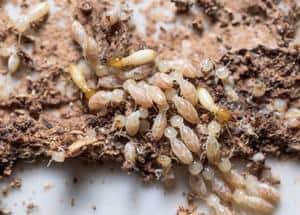In nature, there are various types of insects that are similar to each other. Many inexperienced gardeners often confuse flying ants with termites.
However, the external difference between them is noticeable even to the naked eye if you know what exactly you should pay attention to.
Knowing which pest has settled in your area is important for choosing correct control methods. In this article, I will look at the difference between termites vs. flying ants and tell you about the features of each species and the most effective ways to deal with them.
Flying Ant vs. Termite Guide
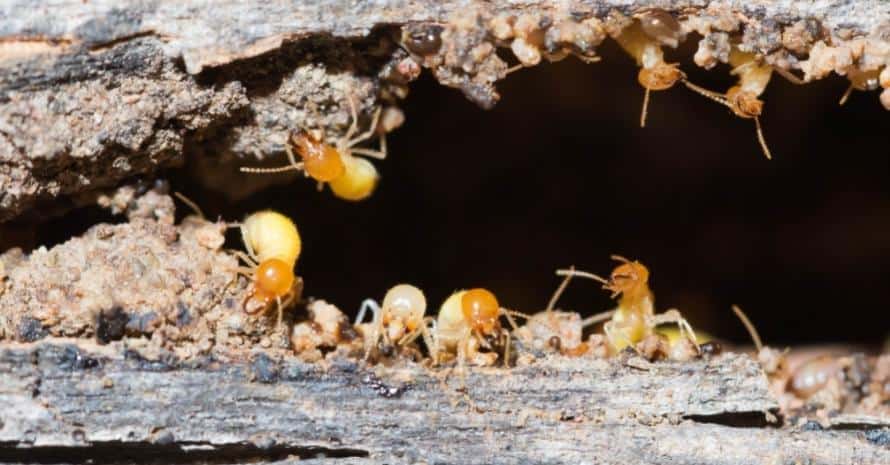
Both ants and termites live in large colonies and inhabit almost all continents (except Antarctica). Despite the apparent similarity, they differ in external features and social lives.
Below I have covered all the key aspects so that you can get a detailed understanding of the difference between these types of insects.
Appearance
Flying ants and termites are relatively small creatures that are nevertheless easy to spot with the naked eye. As a rule, we most often encounter the so-called “workers” in everyday life.
They make up the vast majority of a colony and are engaged in taking care of a family, getting food, caring for larvae, cleaning rooms, and so on. Let’s look at the difference between flying ants and termites, using this caste as an example.
- Color: Working ants are dark in color. Their shade can vary from dark red to brown and almost black. On the other hand, termites mostly have beige or creamy bodies, which makes them appear translucent.
- Body shape: Ants have well-defined narrow waists as if tightened by something. Termites, on the contrary, have uniformly elongated bodies without any changes in abdomen areas.
- Wings: Both species have four wings. In ants, they are short, and the fore wings are much wider than the hind wings. Termites have dragonfly-like wings that are considerably longer than their bodies. Despite having wings, both ants and termites primarily use their legs for locomotion; they fly for a very short time. After mating, both species shed their wings.
- Antennae: In ants, they are strongly curved, as if broken; termites, on the contrary, have absolutely straight or slightly curved antennae.
Behavior
Ants and termites are social insects that live in huge groups. The first ones live in nests called anthills. They can be built from small organic particles or organized in soil, fallen trees, and under rocks. At the same time, ants do not eat wood but only gnaw out rooms in it.
Some parasitic species can “settle” in the nests of other insects. Up to five million ants can live in large anthills. The workers actively forage on the surface, so they often catch our eye.
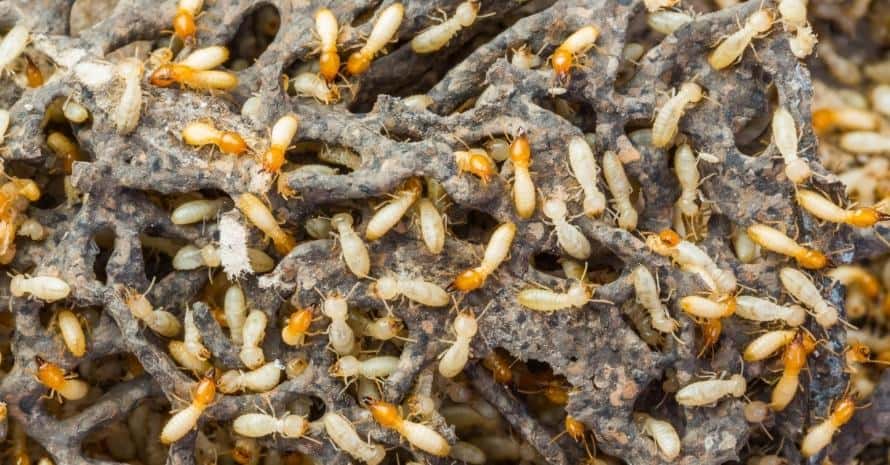
Termite nests are called termite mounds and can be enormous (about 10 feet in height). It is believed that these are the largest structures built by land creatures. These insects mostly move underground, so they are not as visible as ants.
However, they can also organize their nests in a tree. They eat wood, so you will not see wood chips next to inlets, as with anthills. Because of it, termites are a particular threat to human wooden structures.
Food
Flying ants are omnivorous insects. They eat everything literally: plants, mushrooms, seeds, other insects (including dead ones), honeydew, and so on.
Adults consume mainly carbohydrates, while larvae prefer protein foods. The Attini species, for example, has mastered agricultural skills and learned to grow mushrooms in anthills.
The basis of the termites’ diet is cellulose, which is found in large quantities in plants and trees. They have evolved complex and unique intestinal microflora to digest this material well.
Certain species of termites, like ants, have learned to grow Termitomyces fungi, which turn cellulose into edible compost and maintain a microclimate in nests.
Life cycle
The life cycles of ants with wings or termites are very similar. The former go through three stages: egg, larvae (sometimes called a nymph), and adult. After the larva phase, the latter has one more “pupa” step.
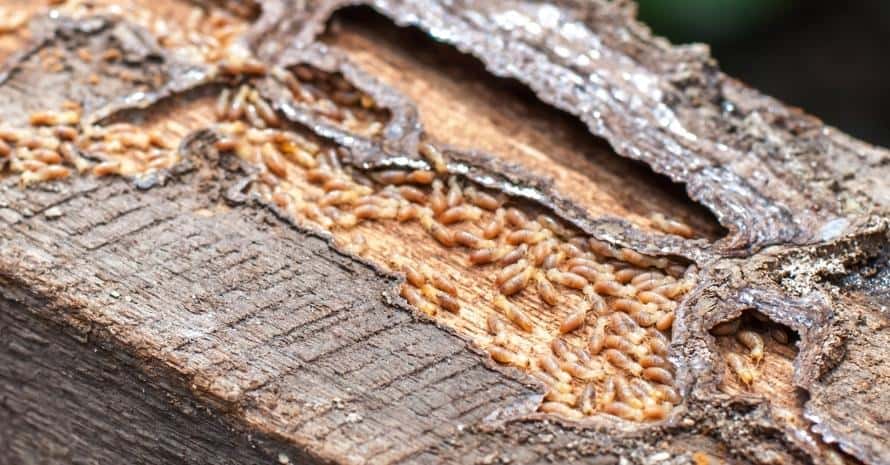
Ants may have one or more reproductive females (queens) depending on the colony size. Most of the families are barren female workers; males usually die after mating. The situation is about the same in a termite colony, but castes are laid down genetically and not due to social changes.
That is why they are considered more advanced genetically. Termites have a king and queen who produce eggs and workers and soldiers to keep the entire family safe.
Damage
There can be many advantages to having an ant-looking bug with wings in your backyard. However, if such insects breed and build several anthills, there will be much more disadvantages:
- they devour tender plants and sweet crops (strawberries, beets, tomatoes, etc.);
- ants like aphid secrete called honeydew, and therefore carefully protect aphids and help them move from bush to bush;
- in addition to sweet crops, they harm flowering plants;
- their active construction activity destroys flower beds, lawns, and even the foundations of houses;
- the soil next to an anthill always has higher acidity, which can be detrimental to some plants;
- ants contribute to the spread of weeds as they eat their seeds;
- these insects can carry fungal and viral diseases, infecting plants in your yard;
- bites of some species are very painful and can be deadly for people with hypersensitivity and allergies.
A neighborhood with ants is both harmful and beneficial. Therefore, your main task is to find proper pest control. If there are not many of these insects yet, you should not disturb them. Termites are traditionally considered absolute pests:
- they easily gnaw even hardwoods, which dramatically increases the likelihood of collapse of wooden buildings and death of people;
- in addition to trees, they also eat fabrics and paper;
- they release bacteria when they bite that cause a severe allergic reaction and provoke a rise in temperature, Quincke’s edema, dizziness, and so on.
The main danger of termites is that they are unobtrusive and pose a hidden threat. You may not know that insects gnaw on your patio’s support beams until the roof collapses. A small colony can eat a huge tree in a couple of days.
Control methods
Both synthetic insecticides and natural repellents can be used to deal with ants and termites. However, first of all, you need to investigate the territory or room they wound up in and determine what exactly could attract them.
Remove all sources of food and liquids, close trash cans carefully, and dry areas where moisture accumulates.
After that, you can apply diatomaceous earth, boric acid, kerosene, and other means in places of accumulation and movement of ants. If you don’t have pets, you can use synthetic insecticides such as those containing Fipronil or Pyrethrum.
In areas where you have found signs of termite infestation, you can also use diatomaceous earth and boric acid. Additionally, use termite sprays and scatter granular insecticides that serve as poison bait. Look for Chlorfenapyr, Fipronil, and Imidacloprid in pest control tools.
Since it can be difficult for amateurs to determine how deep termites have penetrated your house, at the first sign, I recommend contacting specialists. They will be able to solve this problem more quickly.
Flying Ant vs. Termite FAQ
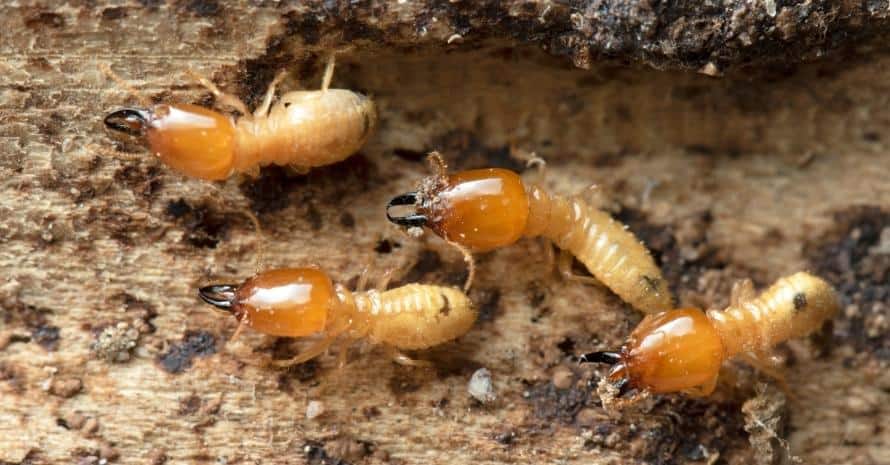
In this block, you will find my answers to common questions from readers about ants with wings and termites.
Are flying ants a problem?
By themselves, they are not dangerous. If you see a flying ant, you can be sure it looks for a mating partner. At the same time, it means that there is a full-fledged colony somewhere nearby, and now this is a problem.
Besides, a mated female can organize its own colony if it finds a suitable nest site.
Can flying ants damage your home?
Unlike termites, ants do it indirectly. If they build an anthill near your house, it may damage the foundation or walls as the colony grows. Ants, including their flying species, do not feed on wood and other building materials but gnaw on them to create passageways.
Do flying ants eat wood?
No, they do not eat wood, but they can gnaw tunnels into them, pushing the wood shavings out. By accumulations of wood dust, you can determine whether you have ants or termites.
Can flying ants live in walls?
Unfortunately, it is possible if there are all conditions for it: high humidity, the presence of easily accessible food, rotten wall material, and so on. Carpenter ants are especially predisposed to it.
Learn to Distinguish Flying Ants or Termites for Effective Fighting
I know how annoying insects can be. That is why it’s important to distinguish them from each other and understand the peculiarities of behavior to choose the most effective elimination method.
Being quite experienced in pest control, I can say that it is best to adhere to an integrated approach and use several tools simultaneously. I hope that after reading my article, you will be able to determine which insects you have clearly.
Have you ever experienced ant or termite infestation? What methods have been the most effective in your case? Please share your tips with other readers!
Also read
- How to Get Rid of Drywood Termites
- How to Get Rid of Subterranean Termites
- Carpenter Ants vs Termites
- Termite Droppings
- Ants in Walls
- Flying Ants in Pool
- Ants in Carpet
- Bugs That Look Like Termites
References
- Carpenter ants(Carpenter ants)
https://extension.umn.edu/insects-infest-homes/carpenter-ants - Termite Infestations(Institute of Agriculture and Natural Resources Nebraska)
https://lancaster.unl.edu/pest/resources/termiteinfestations.shtml - Aphids(Agriculture and Natural Resources, University of California)
ipm.ucanr.edu/PMG/PESTNOTES/pn7404.html#MANAGEMENT - Fungal symbiosis(Termite Research)
https://www.esf.edu/efb/turner/termitePages/termiteFungSym.html

